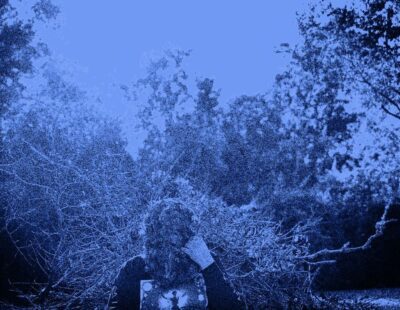
When I reach out to Temple Koludra mastermind M:W to get a bit more insight into the brilliantly conceived and executed amalgamation of Indian instrumentation/spirituality and transcendent, completely leveling atmospheric blackened death metal found on Seven! Sirens! To A Lost Archetype — out June 14, via Transcending Obscurity — the first thing I receive back is a quote from Aghori Vimalananda:
What is really necessary is to cremate all your limitations — to burn down everything that stands in the way of your perception of reality.
“The art of Temple Koludra aims at the creation of a connection — a gateway for the transition between the artificially polished modern spirit and the raw, chaotic current of the primordial consciousness that rests in all things and can never be fully erased,” the multi-instrumentalist tells Decibel. “The lost archetype. The break with habitual and learned structures and the search for authenticity and clarity characterize this path.”
This is as fitting an introduction to the band’s towering work as any — though M:W had much, much more to say. All of which you can read in its full mystical, intriguing glory below as you check out an exclusive stream of the track “Namarupa.”
M:W:
Temple Koludra was founded in 2010 in Frankfurt, Germany. The meaning of Koludra could be rendered as “concurrence of the whole.” The word is deduced from the latin term “Colubra,” which means colubrid — snake. It is further connected to the meanings of Ouroboros — the whole — and of the English verb “to collude.”
The chaotic black metal was enriched with ritual instruments from different traditions of the Himalayan region, which underlines the endeavor to create a culture-overcoming symbiosis. It is well known that these instruments in their culture always were used in a ritual context in order to achieve spiritual transcendence and to experience or influence reality in deep contemplation – the ultimate purpose of music in general. Subtle synthesizer sounds and samples complement the spectrum and ensure a dense aural network. Cascades of guitars, sometimes sublime, sometimes more dominant, pollute this soundscape and form a fragile counterbalance to the eruptive passages.
Lyrically, too, this devotion to the East is evident. For example, the opening track “Trimurti” embraces the three basic principles, creation, blossom, destruction — which are married in an eternal cycle. “Namarupa” transcending the limitations of matter and form…
The cover art also gives an idea of the diversity of the far Eastern pantheon. Charmunda, a terrifying and eerie deity, is intimately bonded with creation, which can only be sustained when Charmunda‘s own self-consuming energy is renewed again and again by the blood of human and animal sacrifices — a powerful metaphor for all beings…
But despite all tendency to reach for the East, these are just translation fragments of the underlying devotion, one that is not geographically located: The shining heart of darkness.
It’s hard for me to summarize the spectrum of my motivations in a single line. Music and lyrics emerge from a hodge-podge of ideas, experiences, observations, visions, preferences, and they only deal with facets of a complex experience in a complex world. This consists of tons of different layers, and frankly, some of these things are very personal, so I’d rather keep them to myself.
The Trimūrti concept is a very interesting. It’s a fundamental principle — or just say the Hindu translation of it. To understand birth, life and death and to experience existence as a dynamic process, something which isn’t static, linear or separated, but a perpetual flow instead, including all cruelty of death and destruction, but also joy and bloom, endless ejaculation of creativity and birth. We all have to come to terms with the fact that everything we value, everything we love, will inevitably be destroyed…
For me as a European living in a capitalist society, which cannot offer anything spiritually meaningful to me, there is a spiritual need. The vamachara or tantrik aspects from this corner of the world are a source of nourishment, so to speak, for unorthodox and undogmatic minds. There is also an interest in tibetan buddhism, which, as is generally known, melted with the old Tibetan shamanism bön. In some cultures you still find this interface to the origin still intact. In Europe or western culture, as a result of its development, nearly all of this was destroyed, therefore it becomes necessary to search for the roots, for parts of this deeply human knowledge that is still alive. I traveled to Nepal and Northern India, for example, to breathe and experience shmashanas, sacrificial ceremonies and pujas. To develop more of an understanding and dive deeper into that world is one of my main goals. Maybe you can only find consciousness or true perception within yourself in the end, but it’s important to gather experience and to get the right tools for that journey…
For sure, Seven! Sirens! To a Lost Archetype has an Eastern focus, and I feel pretty connected to the East, which to me is something like a home that beckons. But despite all my tendencies to reach for the east – these are just translation fragments of an underlying devotion, one that is not geographically fixed: The shining heart of darkness.
I am very interested in the ritual use of musical instruments from different cultures. The world is so full of magical music. When I’m traveling a country, I usually try to buy traditional instruments as souvenirs. Or I do field recordings to capture some interesting stuff, which I could then weave into my compositions. Before the first EP some years ago, for example, I took classes in tibetan throat overtone singing. So it’s something that goes a long way back and feels totally natural for me to marry these sounds with my musical background and socialization. Especially to adapt ritual instruments, which represent or are associated with important aspects of my personal life…

I took care of the visual album design, created all the artwork, which took quite a lot of time.
The iconic mahadevi picture for the album cover was taken at the Maa Kāmākhyā Temple in North East India and we got the permission to use it. Maa Kāmākhyā is a form of Kālī, and in that place they worship her menstruation cycle. It’s one of the many astonishing aspects of this colorful culture, because for the ordinary Hindus the menstruation is something impure.
But consider the way the goddess appears here. In contrast to the usual Hindu goddess depictions with full breasts and a beautiful face, her characteristics are symbols of old age, death, decay and destruction. The statue shows Chamunda, a terrifying and eerie deity. She appears as a frightening old woman, projecting fear and horror. Its intimately bonded with creation, which can only be sustained if Chamunda‘s own self-consuming energy is renewed again and again by the blood of human and animal sacrifices — a powerful metaphor for life itself, and a huge inspiration for the album. A necromantic, universal connection of all creation, bloom, death — a revelation about the miracle of the archetype.






